Book contents
- Frontmatter
- Contents
- List of contributors
- Preface
- Acknowledgements
- Abbreviations
- 1 Practical issues in cytotoxic chemotherapy usage
- 2 Biological treatments in cancer
- 3 Hormones in cancer
- 4 Radiotherapy planning
- 5 Research in cancer
- 6 Oncological emergencies
- 7 Palliative care
- 8 Head and neck
- 9 Oesophagus
- 10 Stomach
- 11 Liver, gallbladder and biliary tract
- 12 Exocrine pancreas
- 13 Colon and rectum
- 14 Anus
- 15 Gastrointestinal stromal tumours
- 16 Breast
- 17 Kidney
- 18 Bladder
- 19 Prostate
- 20 Testis
- 21 Penis
- 22 Ovary
- 23 Body of the uterus
- 24 Cervix
- 25 Vagina
- 26 Vulva
- 27 Gestational trophoblast tumours
- 28 Lung
- 29 Mesothelioma
- 30 Soft tissue and bone tumours in adults
- 31 The lymphomas and myeloma
- 32 Central nervous system
- 33 Skin cancer other than melanoma
- 34 Melanoma
- 35 Thyroid
- 36 Neuroendocrine tumours
- 37 Cancer in children
- 38 Cancer of unknown primary
- 39 The use of radiotherapy in the treatment of benign conditions
- Multiple choice questions
- Multiple choice answers
- Index
- References
6 - Oncological emergencies
Published online by Cambridge University Press: 23 December 2009
- Frontmatter
- Contents
- List of contributors
- Preface
- Acknowledgements
- Abbreviations
- 1 Practical issues in cytotoxic chemotherapy usage
- 2 Biological treatments in cancer
- 3 Hormones in cancer
- 4 Radiotherapy planning
- 5 Research in cancer
- 6 Oncological emergencies
- 7 Palliative care
- 8 Head and neck
- 9 Oesophagus
- 10 Stomach
- 11 Liver, gallbladder and biliary tract
- 12 Exocrine pancreas
- 13 Colon and rectum
- 14 Anus
- 15 Gastrointestinal stromal tumours
- 16 Breast
- 17 Kidney
- 18 Bladder
- 19 Prostate
- 20 Testis
- 21 Penis
- 22 Ovary
- 23 Body of the uterus
- 24 Cervix
- 25 Vagina
- 26 Vulva
- 27 Gestational trophoblast tumours
- 28 Lung
- 29 Mesothelioma
- 30 Soft tissue and bone tumours in adults
- 31 The lymphomas and myeloma
- 32 Central nervous system
- 33 Skin cancer other than melanoma
- 34 Melanoma
- 35 Thyroid
- 36 Neuroendocrine tumours
- 37 Cancer in children
- 38 Cancer of unknown primary
- 39 The use of radiotherapy in the treatment of benign conditions
- Multiple choice questions
- Multiple choice answers
- Index
- References
Summary
Introduction
An oncological emergency is an acute medical problem related to cancer or its treatment, which may result in serious morbidity or mortality if not treated quickly. It may be secondary to a structural/obstructive, metabolic or treatment-related complication (Cervantes and Chirivella, 2004). The emergency may be the first manifestation of malignant disease, particularly for superior vena cava obstruction (SVCO) and malignant spinal cord compression (MSCC).
Spinal cord compression is the commonest neurological complication of cancer, occurring in approximately 5% of all cancer patients. Around 10% of advanced solid tumours give rise to malignant hypercalcaemia.
Types of emergency
Metabolic emergencies include the following:
Hypercalcaemia.
Syndrome of inappropriate antidiuretic hormone (SIADH).
Structural/obstructive emergencies include
MSCC and cauda equina compression.
SVCO.
Raised intracranial pressure.
Acute airway obstruction.
Bleeding.
Urinary obstruction.
Cardiac tamponade.
Pain: this has been named the ‘fifth vital sign’ following pulse, blood pressure, temperature and respiration; when pain is present it should evoke an immediate response. Treatment of pain is considered in Chapter 7.
Treatment-related emergencies include
Neutropenic fever/sepsis.
Anaphylaxis related to a chemotherapeutic agent.
Tumour lysis syndrome.
Extravasation of a chemotherapeutic agent.
Treatment overview
As with any acute medical emergency, resuscitation measures may be needed to ensure that airway, breathing, and circulation are maintained. Adequate hydration, oxygen, and monitoring of fluid balance are important in patients with sepsis or tumour lysis syndrome. Steroids are used in patients with SVCO and suspected spinal cord compression, although the evidence base supporting their use is poor. Mannitol infusions may be needed for severe symptomatic raised intracranial pressure that does not respond to steroids.
- Type
- Chapter
- Information
- Practical Clinical Oncology , pp. 70 - 82Publisher: Cambridge University PressPrint publication year: 2008



